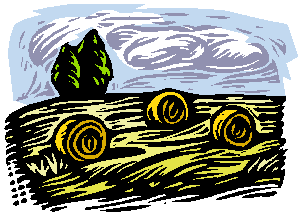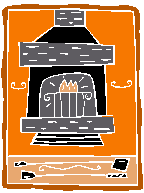

To send a message to an author, click on the author's name at the end of the article.
This Month in Ag Connection | Ag Connection - Other Issues Online

Pasture, Rangeland and Forage (PRF) insurance is a new pilot group risk protection program offered by the USDA Risk Management Agency (RMA). This innovative program is only being offered in a few states. Some states will be based on vegetation greenness and others on rainfall indices. Missouri will be based on rainfall indices.
PRF insurance for 2009 will be available in Missouri from crop insurance agents. This new insurance must be purchased by November 30, 2008. The purpose of the program is to provide livestock producers the ability to purchase insurance protection for losses of forage produced for grazing or harvested hay.
PRF insurance policies use innovative technology to assess losses in forage production across diverse range and pasture environments in many states. The Rainfall Index used in Missouri is based on National Oceanic and Atmospheric Administration (NOAA) data and will use an approximate 12 x 12 mile grid. Producers must select at least two 2-month time periods in which precipitation is important during the growth and production of forage species. These time periods are called index intervals. Insurance payments to a producer suffering a loss are calculated based on the deviation from normal precipitation within the grid and index interval(s) chosen. This insurance coverage is for a single peril - lack of precipitation.
There are some rules for the program including seeding and overseeding. To establish a pasture, the deadline is July 1 prior to the insured year. So if you want insurance in 2009, the pasture must have been established prior to July 1, 2008. The program does allow overseeding into an existing stand.
This insurance policy will count towards insuring all acres for the new farm bill. Some programs affiliated with the new farm bill are going to require insurance on all acres, including pasture and hay acres. The PRF insurance is one choice of insurance on the pasture and hay acres. For more information contact a local crop insurance agent, or visit the RMA website http://www.rma.usda.gov.
(Source: Mary Sobba, Agriculture Business Specialist)
This Month in Ag Connection | Ag Connection - Other Issues Online
Part I - With the recent cool nights the thought of heating your home may have crossed your mind. Then one realizes the cost of energy is higher than ever. Is there anything one can do? There are alternative heat sources to investigate as a possible replacement to traditional propane or natural gas.
The focus of this two-part article will be on the use of wood stoves, pellet stoves and corn stoves for home heating. Pellet stoves burn compressed sawdust pellets that are automatically fed into the combustion chamber from a hopper, while corn stoves burn shelled corn. This month wood stoves will be discussed.

Wood stoves, as the name implies, burn wood to produce heat. Wood is a plentiful and readily accessible fuel in our region. It burns relatively clean and is a renewable energy source.
Wood stoves come in many shapes and sizes depending on your application. They can either be freestanding units or be designed to fit into your fireplace opening. Many of these units feature a glass pane in the door so that you can visually enjoy the fire too. There are wood stoves available that can dump heat directly into your existing central heating system or large outside units that boil water to supply heat to your home. For the purpose of this article, the focus will be on the standard "room type" stove.
Cast iron is the most popular material for manufacturing wood stoves although steel is also used. Cast iron stoves take a little while to warm up, but they continue to radiate heat after the fire has cooled. Steel stoves heat up quickly but they also cool quickly and tend to wear out quicker than cast iron stoves. To increase a stove's ability to radiate heat after the fire has gone out, some stoves are lined with firebricks. These bricks absorb heat while the fire is burning and radiate the heat into the room for several hours after the fire has gone out. Some wood stove models can be fitted with small fans and heat exchangers that can further increase their efficiency and your comfort.
Earlier, fireplace inserts were mentioned. The reason for considering a fireplace insert is that approximately 90% of the heat goes up the chimney with a conventional fireplace compared to only 40-50% with a wood stove or fireplace insert. Today's modern downdraft stoves can raise this efficiency even higher by reintroducing and burning some of the hot gases that normally escape up the chimney.
The chimney or flue is an import part of your wood burning system that many people erroneously take for granted. Chimneys should be inspected at the start of every wood burning season to ensure there are no cracks in the flue, that the bricks are tight and that there is not an excessive buildup of creosote. It is recommended that you clean the chimney when the creosote reaches a thickness of 1/8 inch to reduce flue fire risks.
The fuel value of wood depends on the variety of the wood as well as the moisture content of the wood. Any wood will burn. However, hardwoods make better firewood than softwoods. They produce more heat energy per pound of wood, burn longer, and produce less smoke and soot. The most desirable species for firewood include ash, birch, oak, hickory and hard maple. Second choices include cherry, soft maple and walnut. All these woods are relatively easy to split and light as well as producing few sparks.
Properly drying or seasoning the wood is extremely important. Dried wood will ignite more readily, burn hotter and produce less creosote and tar in the chimney. Firewood cut green should cure for a full year for best results. To get your wood to dry quicker, cut the firewood to the desired burning length and then split the pieces to less than 10 inches across before stacking. Large random piles of firewood will not dry as quickly as stacked wood. Stacking the wood allows air to flow around the wood promoting faster drying. Avoid multiple stacks of wood close together that can restrict airflow around the wood. An open shed or other covered storage, open on the sides, helps prevent rewetting from rain and snow.
Supplemental heat can be provided for a very reasonable cost by using properly seasoned firewood in a wood stove that is connected to a proper chimney. Thus a wood burning stove can be a very safe and beneficial investment. For additional information, feel free to contact me or stop by your county extension office and ask for guidesheets:
Material adapted from an article by: Jim Crawford, Natural Resource Engineering Specialist.
(Source: Kent Shannon, Natural Resource Engineering Specialist)
This Month in Ag Connection | Ag Connection - Other Issues Online
Beef from market cows and bulls is widely used in the retail and food service sectors in a variety of products - not just ground beef, but also roast beef and other products sold at fast food and other "quick service" restaurants. Producers should focus on market quality of their cull cows and bulls (dairy and beef) as valuable contributors to the beef supply. Producers are consumers too and contribute to sales at quick service restaurants (McDonalds, Arby's, Burger King, etc.) just as much as the average American.
The 2007 Beef Quality Audit found several improvements since the 1999 audit, but still showed plenty of room for progress especially when marketing cull cows and bulls. According to the audit findings, "producers should market their cattle in a timely and appropriate manner, long before their cattle become too thin or lame for transport". In other words, producers need to cull their cows and bulls BEFORE they become so emaciated or lame they are worthless or become "downers". The audit found that producers should consider culling when culls start showing structural and/or other problems, instead of holding onto them trying to get another calf. The longer a producer holds these culls the higher probability that these culls will be condemned at slaughter generating no income.
Also the audit noted that producers really need to be more aware of their culling decisions BEFORE they apply insecticides, wormers or inject drugs such as antibiotics into the animal. If the cull is marketed before the withdrawal date is completed, these products can leave residues in the tissues which could lead to not only contaminated beef, but a possible PR nightmare for the beef industry. Everyone affiliated with the beef industry can agree, WE don't want this.

According to the audit, beef culls with a body condition score of 3 need special attention and consideration when marketing, these culls need enough condition and be sound enough for transport and sale. Consider giving a little extra care to these animals - including a reconditioning program to increase muscle and fat deposition. This also helps increase the value of your culls. This might be something as simple as dry lotting your culls and feeding them for a brief period before selling them to the livestock auction. This can also help identify sick cattle that need to be rendered instead of being transported.
Smaller producers can expand their marketing opportunities by pooling their cattle resources and forming cooperative marketing agreements with each other. Cattle producers already do this for their feeder calves. What is to say that producers couldn't do this with their culls as well? This could help increase profitability of the cow/calf operation and help the beef industry as well.
Don't consider culls as a liability; look at these animals as an asset. Marketing culls at the right time can not only improve the perception of the beef industry as a whole but can also mean the difference between profitability and losing money for an operation. For a copy of the 2007 Beef Quality Audit, contact NCBA at http://www.beef.org or call their office in Denver, CO at (303) 694-0305.
(Source: Wendy Flatt, Livestock Specialist)
This Month in Ag Connection | Ag Connection - Other Issues Online
Fall is the time many cattle producers cull problem cows. Cull cow sales can make up 15 to 20 percent of the income on many beef cow/calf operations. Understanding the USDA cull cow grades may help you make smart cull cow marketing decisions. Dr. Glenn Selk at Oklahoma State University summarized the USDA cull cow grades and the following information is taken from his article.
The USDA market news service reports on four classes of cull cows. The four classes are divided primarily on fatness. The highest conditioned cull cows are reported as "Breakers". They are usually quite fleshy and generally have excellent dressing percentages. Body condition score 7 and above are required to be "Breakers".
The next class is a more moderate conditioned group of cows called "Boners" or "Boning Utility". These cows usually would fall in the body condition scores of 5 to 7. Many well-nourished commercial beef cows would be graded in this category.
The last two groups are "Leans" and "Lights". These are very thin cows with body condition scores of 1 to 4. They are, in general, expected to be lower in dressing percentage than the fleshier cows and are more easily bruised while being transported than are cows in better body condition. "Lights" are thin cows that are very small and would have very low hot carcass weights.
"Leans" and "Lights" are nearly always lower in price per pound than "Boning Utility" and "Breakers". Lights often bring the lowest price per pound because the amount of saleable product is small, even though the overhead costs of slaughtering and processing are about the same as larger, fleshier cows.
How does this impact your income from cull cow sales? Recent Missouri Department of Agriculture price reports for prices received for cull cows in central Missouri livestock markets have "Lean" cow prices at about $0.50 per pound. Prices for "Breaking" and "Boning" were reported at about $0.535 per pound at the time of this writing. Assuming we have a 1,000 pound "Lean" cow at the above price, our returns from this cow are $500. If we add 1 body condition score to this animal (which equals about 100 pounds) and she hits the "Boning Utility" grade, we now have a 1,100 pound animal that is worth approximately $0.535 per pound which brings in $588.50. If you can add 100 pounds to a cow for less than $88.50, you are money ahead to do so.
Because of the plentiful rains in much of Central Missouri this summer, many producers have surplus pasture. Dry cows can add weight very quickly on fall pasture. If you have thin cull cows to sell and plenty of fall pasture, consider putting additional weight on them prior to sale. The extra income is sure to be welcome this year.
(Source: Gene Schmitz, Livestock Specialist)
This Month in Ag Connection | Ag Connection - Other Issues Online
The benefits - less time and strain, returning nutrients and organic matter to the turf, and the environmental benefits of reduced smoke, landfill waste, bag usage, or transport costs are just a few. Also, the trees will thank you for recycling the minerals in their leaves rather than hauling them away and then trying to replace them from a fertilizer bag.
Tips for Mowing Leaves

(Source: James Quinn, Horticulture Specialist)
This Month in Ag Connection | Ag Connection - Other Issues Online
Publishing Information
Ag Connection is published monthly for Northeast and Central areas of Missouri producers and is supported by the University of Missouri Extension, the Missouri Agricultural Experiment Station, and the MU College of Agriculture, Food and Natural Resources. Managing Editor: Mary Sobba.